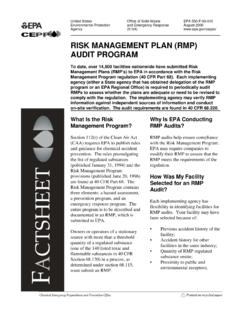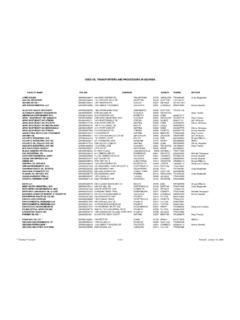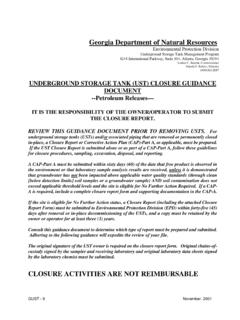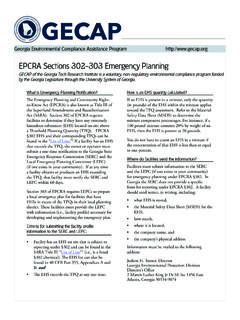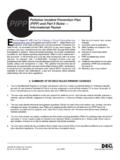Transcription of GECAP
1 And not regulated under Underground Storage Regulations found at 40 CFR 280. As few as 25 55-gallon drums can trigger the SPCC regulation. The 1,320 gallon threshold quantity relates to oil storage capacity. Therefore, if you have an oil storage tank that can hold 500 gallons of oil, however, you only keep it half full, you still must count this tank as 500 gallons according to SPCC regulations. Oil storage also includes quantities of oil stored within equipment/machines above the de minimis capacity of 55-gallons. Oil stored in containers that have a capacity of 30-gallons, 5-gallons or quarts, for example, are exempt from this regulation, including the threshold quantity assessment; only containers with the capacity to hold 55 gallons or more have to be counted.
2 Oil water separators used for wastewater treatment or used as secondary containment for another bulk container are exempt from types of facilities are considered to be non-transportation-related?This term refers to all fixed facilities and includes support equipment, but excludes interstate pipelines, railroad tank cars en route, transport trucks en route, and terminals associated with the transfer of bulk oil to or from water transportation vessels. The term also includes mobile or portable facilities, such as onshore drilling or workover rigs, production facilities, airports, hospitals, military installations, and portable fueling facilities whenever they are at a fixed, operating Environmental Compliance Assistance Program Spill Prevention, Control, and Countermeasures PlanGECAP of the Georgia Tech Research Institute is a voluntary, non-regulatory environmental compliance program funded by the Georgia Legislature through the University System of is the Environmental Protection Agency s (EPA) Oil Pollution Prevention regulation?
3 It is the regulation that exists to prevent oil spills from reaching the waters of the United States. The Spill Prevention Control and Countermeasures (SPCC) plan is an output of the Oil Pollution Prevention Regulation (OPPR), which originated in the Federal Water Pollution Control Act of 1972 (later renamed the Clean Water Act). The regulation establishes requirements for owners or operators of facilities that drill, produce, gather, store, process, refine, transfer, or consume oil. The text of the regulation is found in Title 40 of the Code of Federal Regulations, Part 112 (40 CFR 112).Which facilities are affected by this regulation? In particular, the regulation applies to non-transportation-related facilities that could reasonably be expected to discharge oil in harmful quantities into navigable waters of the United States and that have an aggregate above-ground oil storage capacity of more than 1,320 gallons.
4 The regulation applies specifically to a facility s storage capacity, regardless of whether the tanks are completely filled. Storage capacity includes the capacity of all oil storage containers, including transformers, with a 55-gallon capacity or SPCC plan is required if you store more than 1,320 total gallons of oil above ground combined from all sources OR if your total buried oil storage capacity is greater than 42,000 gallons GECAP1for less than three years. Facilities are required to implement the SPCC plan by carrying out the SPCC measures established for the type of facility or operation, such as preparing to contain a spill within dikes or berms. If containment measures cannot be implemented, a spill contingency plan must be developed and incorporated into the SPCC plan.
5 What should the SPCC plan include? Detailed SPCC plan requirements are found at 40 CFR The SPCC plan must be carefully thought out, prepared in accordance with good engineering practices, and be approved by a person having the authority to commit the resources necessary to implement the SPCC plan. The SPCC plan should address: operating procedures that prevent oil spills; control measures installed that can prevent a spill from reaching navigable waters; and countermeasures to contain, clean up, and mitigate the effects of an oil spill that impacts SPCC plan must be unique to the facility, requiring that the developers of the SPCC plan have detailed knowledge of the facility and the potential effects of any oil spill.
6 In addition, each SPCC plan must include certain standard elements to ensure compliance with the regulations, including: a summary of facility operations and the date of initial operation; facility person responsible for oil spill prevention; written descriptions of any spills, corrective action taken, and plans for preventing their recurrence; a prediction of the direction, rate of flow, and total quantity of oil that could be discharged Does this regulation apply only to petroleum oil storage? No, the SPCC regulations apply to oil of any kind. Oil, as defined under SPCC, can be new or used, of any kind or form, including, but not limited to petroleum, hydraulic, mineral spirits, vegetable transformer oil, or diesel oil.
7 It may be difficult to determine if some materials are considered oils. A List of Oils is available at This list is not all-inclusive, but can be used as a guide in the identification of oils located at the facility. What are Navigable Waters of the regulatory definition can be found at 40 CFR Navigable Waters can include seas, bays, gulfs, lakes, rivers, streams (including intermittent streams), sewers, ditches, creeks, ponds connected to the tributary system in a river basin, wetlands, mudflats, sandflats, sloughs, prairie potholes, and wet meadows. Jurisdictional reach may also include groundwater if it is directly connected hydrologically with surface waters.
8 What does this regulation require of a facility? The Oil Pollution Prevention Regulation requires that all applicable facilities have a fully prepared, facility-specific, and implemented Spill Prevention Control and Countermeasures Plan. Some SPCC plans must be certified by a registered professional engineer (PE). Following a December 2006 change to the Federal regulation, if a facility meets certain requirements and has a storage capacity of less than 10,000 gallons, the SPCC plan may not need to be certified by a registered professional engineer (PE). The requirements are: the facility must not have had (1) a single discharge of oil to navigable waters exceeding 1,000 gallons or (2) two discharges of oil to navigable waters each exceeding 42 gallons within any twelve-month period, in the three years prior to the SPCC Plan certification date, or since becoming subject to 40 CFR Part 112 if facility has been in operation 2where experience indicates a potential for equipment failure.
9 A description of containment and/or diversionary structures or equipment to prevent discharged oil from reaching navigable waters (for on-shore facilities, one of the following should be used as a minimum: dikes, berms, retaining wall, curbing, culverting, gutters, weirs, booms, spill diversionary ponds, retention ponds, and sorbent materials); an up-to-date inspection report describing the facility s equipment, containment procedures, operations, drainage, and security; personnel training records; documentation of SPCC plan reviews (the facility owner or operator must review the SPCC plan at least once every five years); a signed statement of management s commitment to the SPCC plan; and certification by a registered professional engineer, if example SPCC plan can be viewed on EPA s website at within the guidance document, SPCC Guidance for Regional Inspectors.
10 When do I need to amend or review my SPCC plan?The owner or operator is required to review the SPCC plan at least once every five years. This review must be documented and kept with the plan. The SPCC plan must be amended within six months following the review to incorporate more effective control and prevention technology if the current technology will significantly reduce the likelihood of a discharge, and the technology has been field proven. The plan must also be amended any time there is a change in the facility design, construction, operation, or maintenance that materially affects the potential for a discharge of oil into navigable waters. Do I need to send my SPCC plan to the EPA for review and/or approval?

